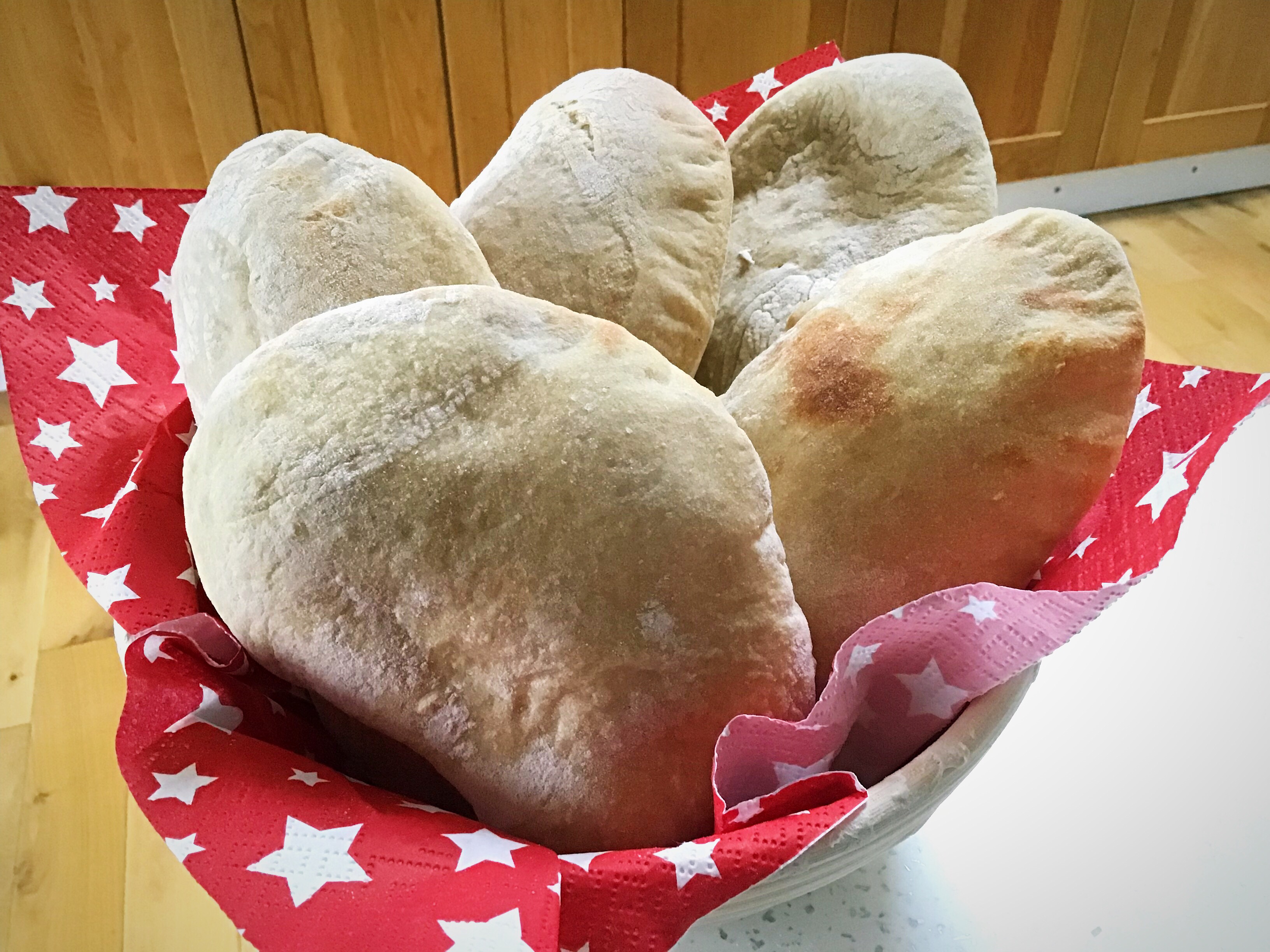





Author: foodbodsourdough
Sourdough Uzbek flatbreads…

I’ve been wanting to try making ‘Lepyoshka’ Uzbek flatbreads ever since I saw my friend Sally make them and, of course, I wanted to convert them to sourdough. So this week I did!

I purchased the stamp from this Etsy seller a few weeks ago especially; they’re so lovely, it would be easy to fill your cupboard with them!!


I was very happy with my first attempt, you can just about see the pattern created by the special stamp, but moreover, with the addition of yoghurt in the dough they tasted great. They were lovely immediately from the oven, still good a few hours later, and then again just as tasty the next day when heated up again in the toaster.


To make them I made a stiffer dough than usual by using a mix of wholemeal and white flour, plus the yoghurt in place of water. I used a 0% fat Greek yoghurt (just because that’s what I had available, I’d use full fat next time) so it added a real tang to the flavour, and an almost cheesy taste once baked.

To use the stamp and stop it from sticking to the dough I dunked it in water for each use, then firmly pressed it into the dough and pulled directly back up and out again.
For these I used up lots of young starter, from the starters I’ve been playing with in my kitchen recently, and less yoghurt, but you don’t need to. You could use less of your established starter and more yoghurt to create the same consistency in the dough.
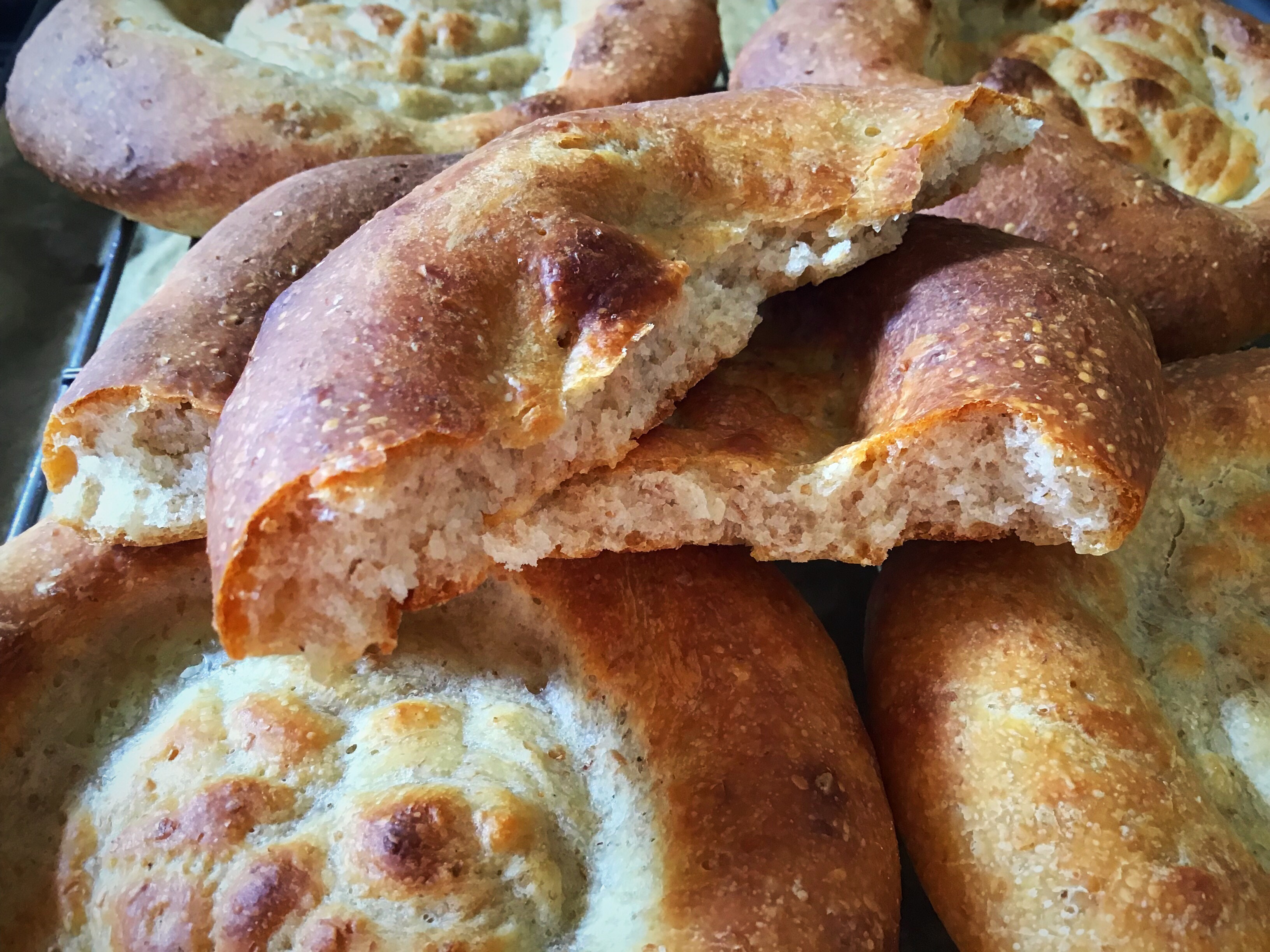
Ingredients
300g young starter
100g thick Greek yoghurt
200g strong white bread flour
50g strong wholemeal flour
20g olive oil
1tsp salt
Method
I used my usual master recipe process to create and build up the dough, then placed the bowl in the fridge overnight for it to develop, as well as to protect it from the warm night.
The next day I let the dough come back up to room temp, sprinkled the counter with water then turned the dough out onto the counter and cut it into equal(ish) portions.
I rolled these into balls, flattened them out with my fingers and pressed them into rounds.
I placed each round onto a tray lined with parchment paper and I then used a spoon to flatten out a circle in the middle into which I pressed the stamp.
I then placed them in a cold oven, turned it up to 220C fan and baked them for 17-18 minutes.

The result is a lovely soft edge with a crunchy thinner stamped middle.
I will definitely be making these again, and adding them to my courses 🙂

Nut butter sourdough…

I have been playing with adding nut butters to my doughs; I love nut butters, especially almond butter, so for me to mix of sourdough with nut butter seemed like a marriage made in heaven, and I can now report, that sourdough loves them too!
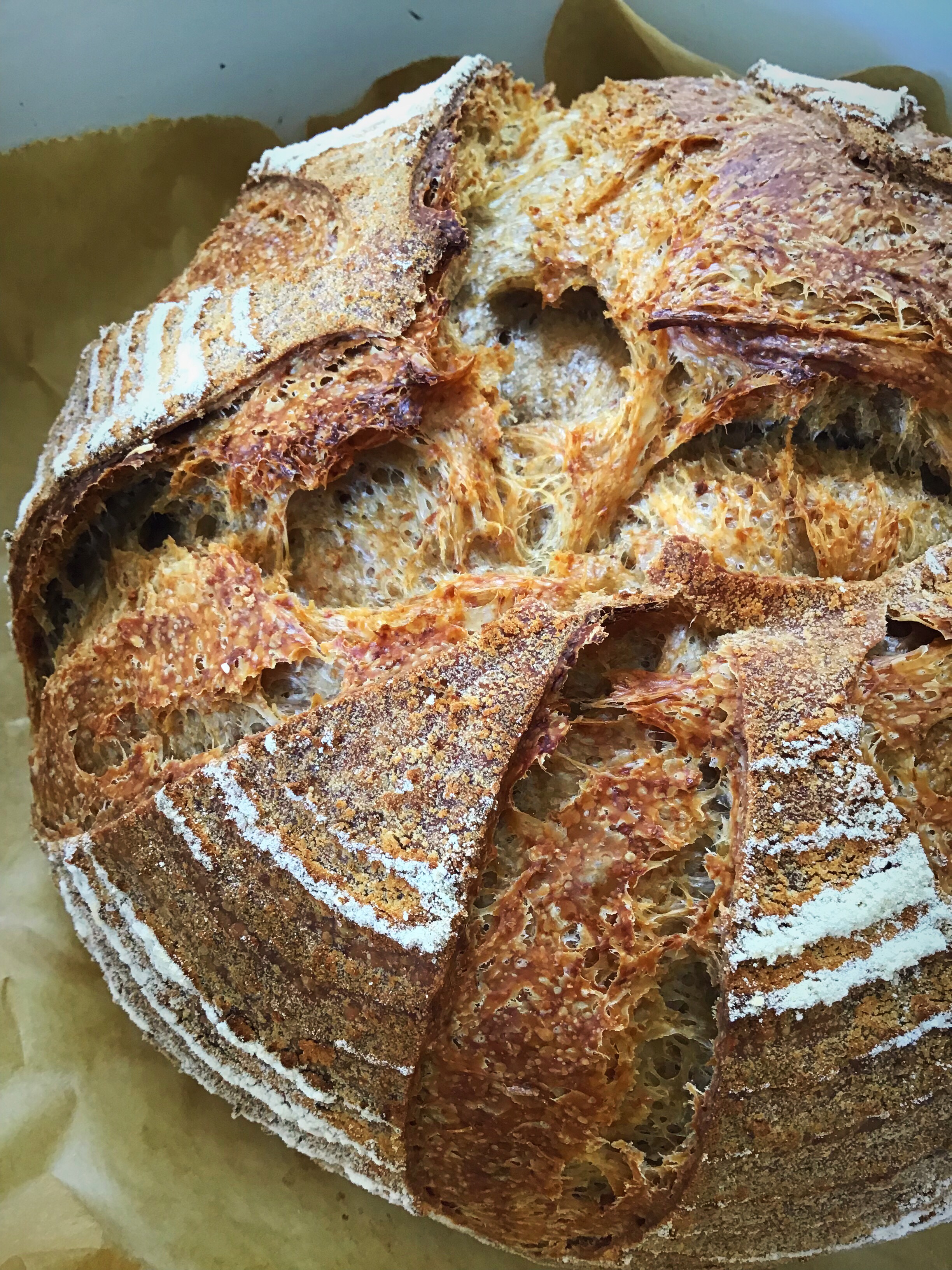
This loaf was made by adding peanut butter to a portion of my starter Star. The loaf came out beautifully, it was very sour and only very slightly nutty, so next time I did things differently.

In this loaf, above, I added 100g of almond butter to the dough and again it was lovely, with a hint of nuttiness and extra sourness.


The texture and outcome was lovely, and you can see the crumb below.


So in this loaf, above, I went further and added 200g of almond butter to my standard master recipe dough, as you can see the dough was wonderfully firm, and the colour from the nut butter spread through it.
This photo below shows just how much the dough grew with the added almond butter..

And this one shows just how lovely and firm the dough became after it’s final prove in the fridge..

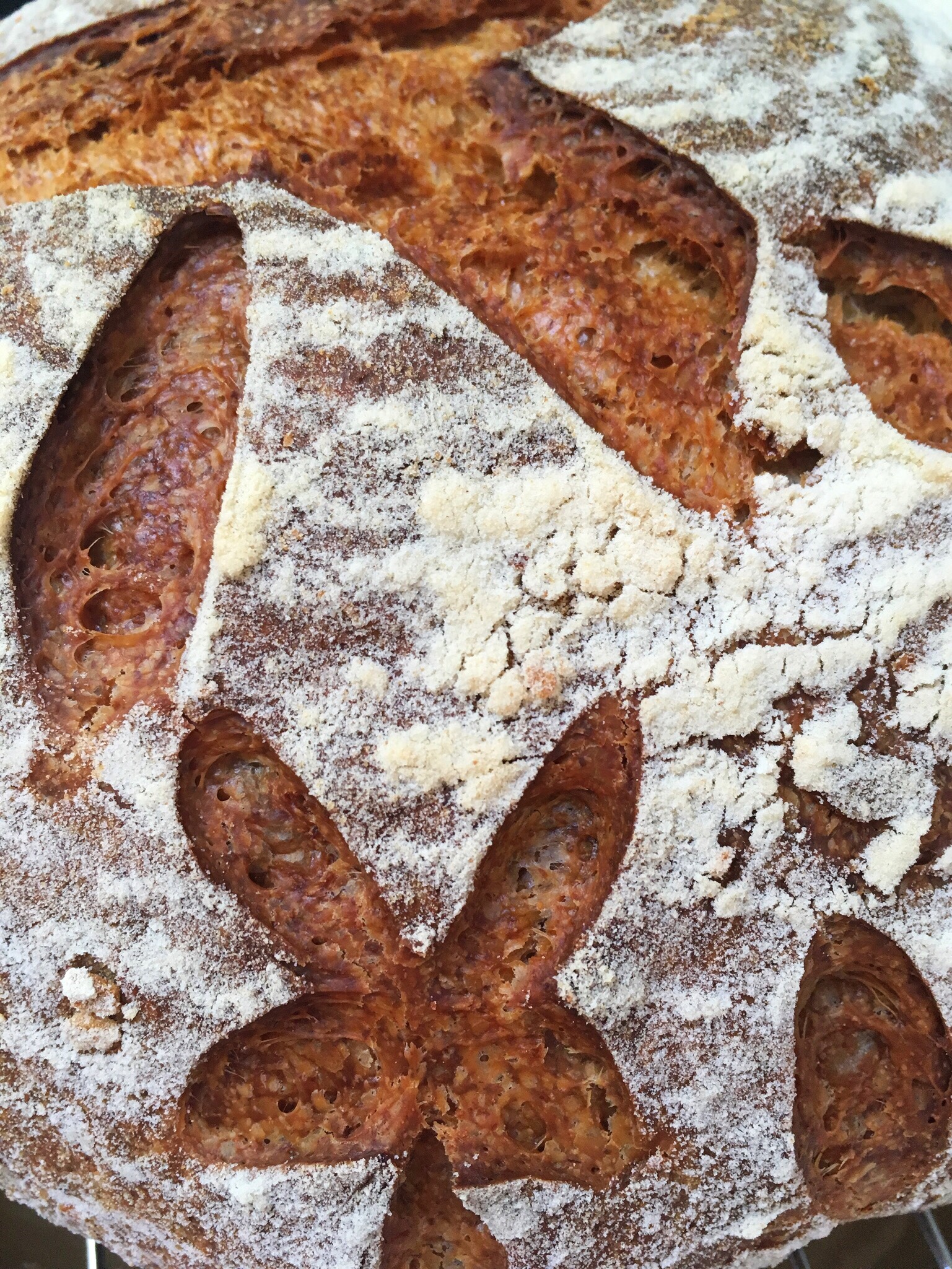

So good! The flavour was nutty and sour and highly recommended. The loaf baked to a lovely crust, with a soft, tasty interior, packed full of the goodness from the almond butter and the extra protein.

The outcome of these loaves and experiments is to say…try it!
Adding nut butters to sourdough works really well. There needs to be enough to taste it if you want the nuttiness, or if you’re looking for a way to make your loaves more sour, try adding 50-100g peanut butter to your dough – it works!
Note: I use nut butters that are made from 100% of the nuts only, with no other additions. If you use nut butters with added salt you might want to reduce the amount of salt that you add to the dough.
To make your dough, use your standard process, I always use my master recipe, and add your portion of nut butter right from the start with everything else.
The dough will be sticky initially but as you work with it the stickiness will reduce and the nut butter will become incorporated.
The dough will be lovely and firm, and the oils from the nut butter will work through the dough without it getting slimy.
If you try it, let me know!

Buttermilk and tahini sourdough loaf…

In my Facebook group, ‘sourdough with foodbod’, I recently launched a new challenge to feed a portion of our starters with something new, the aim being to have fun and to see what we might create, some ideas will work, and some won’t, and that’s the fun of it…
We always feed our starters the best possible flour and water, but what would happen if we fed them something totally different? A different liquid, or a different type of flour, or something instead of flour? Just to see what would happen, what the reaction would be, what the flavour outcome might be..? The possibilities are endless!
**For this challenge, I highly recommend using just a portion of your precious starter, and keeping the rest safe and sound. So for example, I fed my lovely Star and separated some portions of her into new bowls to have some to play with without affecting my standard cherished base amount. I always always make sure that I keep an unadulterated base amount of my precious, beautiful Star whatever sourdough experiments I do.
For this loaf I fed 50g of Star with my favourite buttermilk & tahini sauce; to make the sauce I blended 50g of tahini with a 284ml pot of buttermilk.

And as you can see, Star liked it as much as I do! This photo above shows the mix after 8 hours.


This photo above shows the mix the next morning.
This produced a firm spongy starter, very much like a low hydration starter or ‘pasta madre’, full of lovely texture.
To make the dough I added more tahini to some water (I blended 50g of tahini with 450ml of water) and used that in the dough to add even more flavour, and it worked perfectly. The resulting loaf had a nice crust, and a close crumb, due to the dairy element, and a lovely subtle flavour of sesame seeds. I will definitely do this again.


To try the flavour, you could add the tahini to the dough whilst using your standard starter, or you could play with it like it did.
This is what I did..
Day 1
I fed 50g of Star with 30g of strong white bread flour + 30g of my buttermilk & tahini sauce (details above), covered and left on the counter
8 hours later I fed the whole mixture 50g of strong white bread flour + 50g of buttermilk & tahini sauce, covered and left on the counter overnight

Day 2
I had a bowl of lovely textured thick happy starter, as seen above.
To mix up the dough I used:
100g of the buttermilk & tahini starter
500g of strong white bread flour
350g of a water and tahini mix
1tsp salt
I then followed my usual process to work with the dough and bake her the next day.
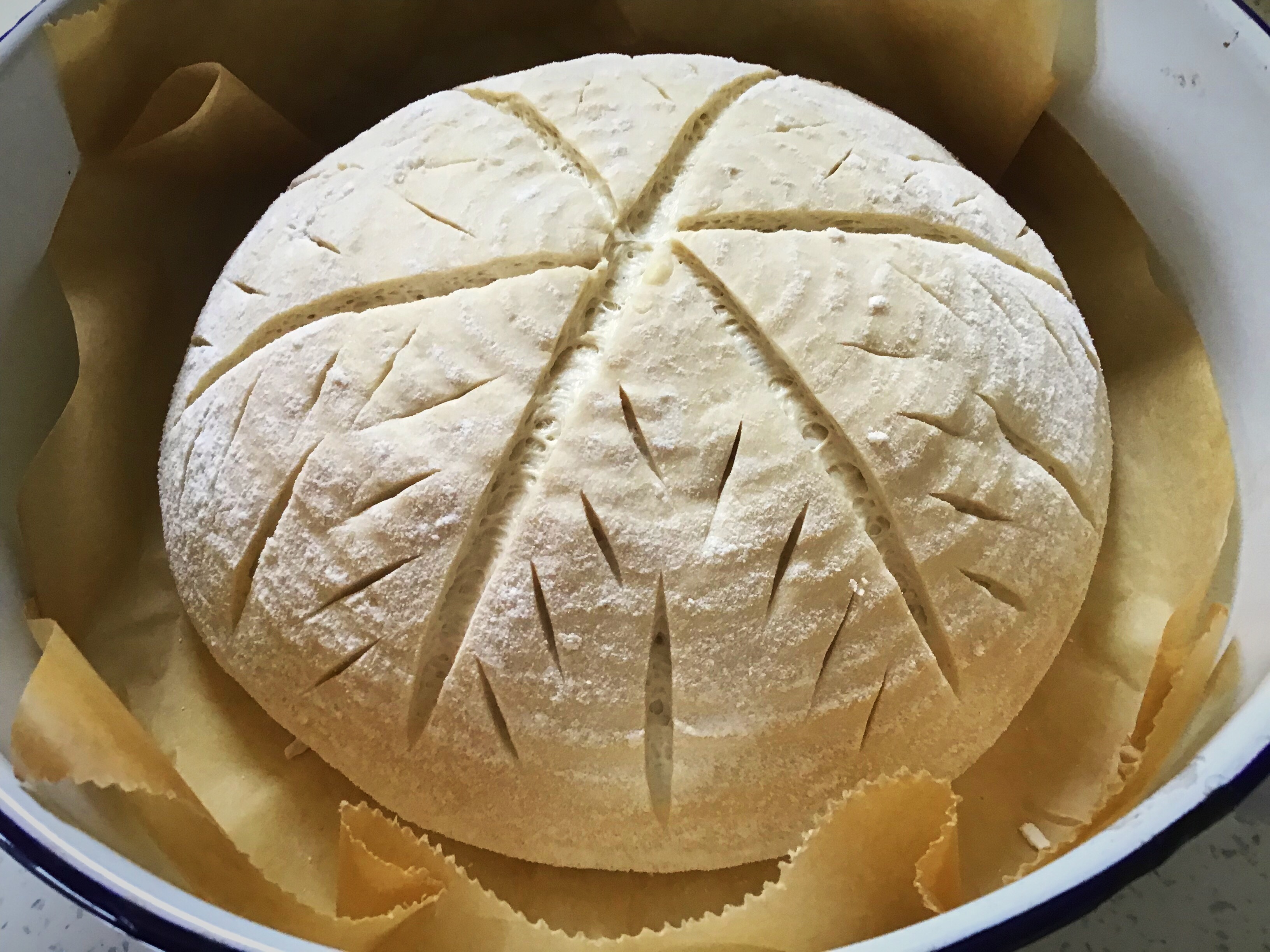

The dough was lovely and firm, a joy to score, and it baked beautifully from a cold start.

The crumb was closer than other loaves might be, this is due to the dairy element. You could really smell the tahini in the bread and you could taste it in each bite without it being too strong.
Definitely a success in our house!
If you decide to experiment with your starter, do tag me and #starterfun wherever you share it, and enjoy the fun! I’ve already got more experiments to share, coming soon…
Leftovers loaves…

You know how it is, you open your baking cupboard and you’ve got various bags of flour, with various amounts left, but not enough for an entire dough…

So the only thing to do is to throw them all together and hope for the best?! That’s what I did this week. And these loaves were the outcome..


These include portions of strong white bread flour, malted multigrain flour, khorasan flour and a seeded flour mix, all thrown together in various quantities to make up my normal 500g amount of flour for my master recipe.


As you can imagine, I was happy with the outcome!


I love seeing how the activity in Star and then the dough after it’s overnight prove translates into the dough…it never ever gets boring!
Happy Baking!
My master recipe with wholemeal/wholewheat flour…

If you would like to use wholemeal/wholewheat/whole grain flours with my master recipe, it is easily converted.
Please note that you can use whatever starter you have, the flour is your starter does not have to match the flour in your dough.

My master recipe is very easily converted to include different flours, and ingredients, it provides a base for you to create whatever version of sourdough you fancy. And this includes using wholemeal flours (that’s what it’s called in the UK; it can be called wholewheat and/or wholegrain).
This loaf, above and below, was made using 250g strong white bread flour and 250g strong wholemeal bread flour. Everything else remained the same as my master recipe: 350g water, 50g starter, 1tsp salt. I used the same process as always and baked for the same time.

This mix can be baked successfully from a hot or cold oven start.
The loaf below was made using only wholemeal flour; this was a smaller loaf made with 300g strong wholemeal bread flour, 220g water, 30g starter and 3/4tsp salt. Everything else the same.

The nature of wholemeal flour is that it will always produce a closer crumb, that’s very typical and to be expected.
You will find that the dough is firmer than a 100% white loaf, and consequently easier to score cleanly and happily.
You will also find that it handle quite differently; in the morning after the overnight prove it only needs a very gentle pull together to place into the banneton. It can then be in the fridge for as long or short a time as you choose.

To see the dough for these loaves in action and the scoring and baked outcomes, check out the video on my YouTube channel: https://youtu.be/9MOJBKrHsC4
Happy Wholemeal Baking!
The story of this week’s course…

This week I had a lovely lady in my kitchen who had travelled especially from Dubai, in the United Arab Emirates. It’s such a compliment that she wanted to come and share my kitchen, and that she follows my baking from so far away.
It was also very close to my heart to welcome her to my home; I lived in Dubai as a child and I have a long connection with the UAE having had parents living Dubai and then Abu Dhabi across 30 years, as well as living there myself full time for 5 years prior to that. It is a place that holds a special piece of my heart and formed many of my food tastes as well as creative influences.
It was a joy to talk to someone who remembers the Dubai that I remember from the 1980’s and to listen to her speak Arabic is a sound I always love!

During the course we focussed on the basics of my master recipe and process, as well as working with wholemeal flour and using doughs for making rolls and other lovely sourdough goodies.
I always make sure that there is lots of dough to play with on my courses to get the feel of how different flours affect the dough but also to be able to turn dough out to make rolls in various guises, including the ones in the photos in this post.
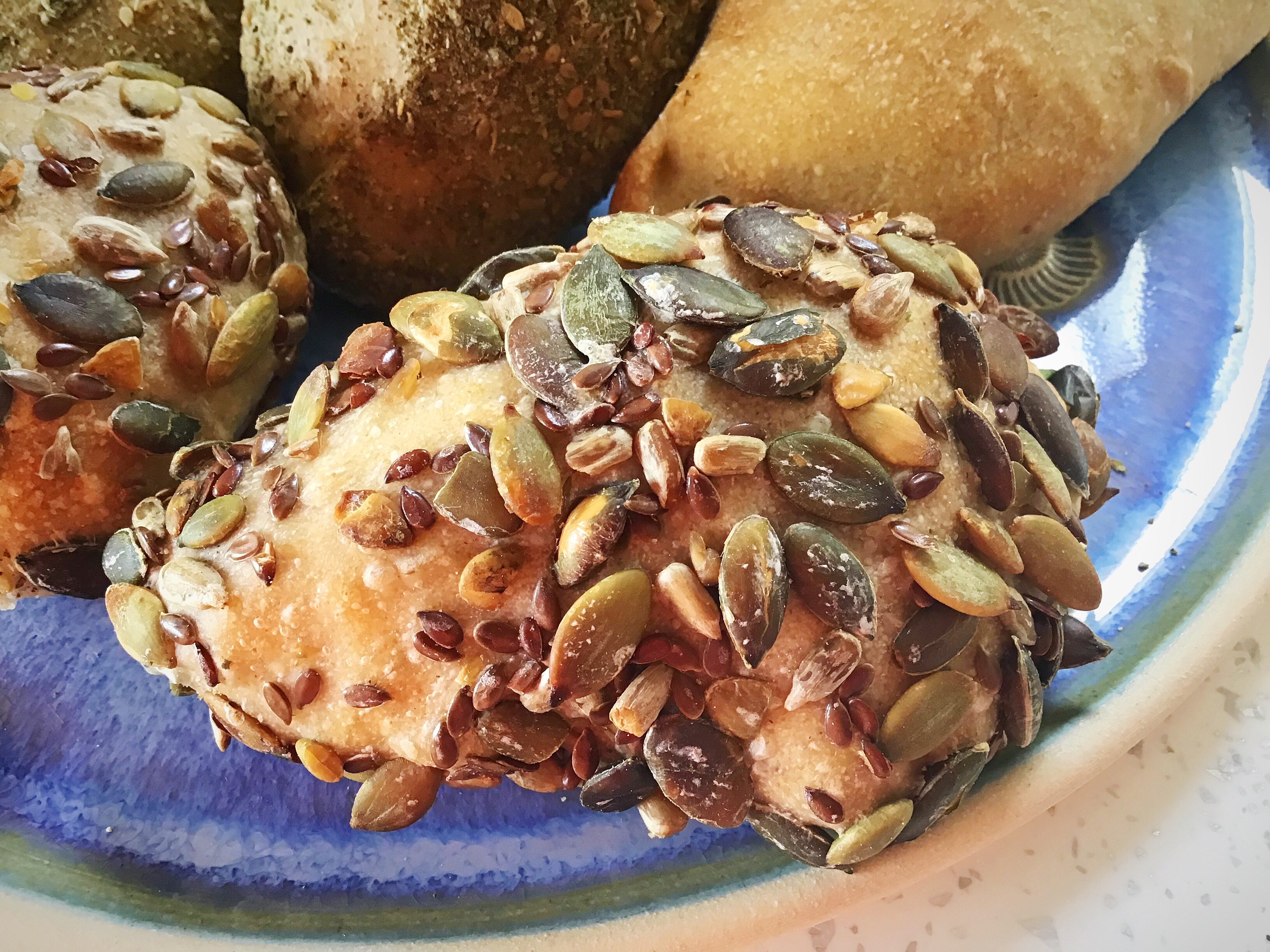
There were all made with my master recipe dough, one portion of which included 150g of khorasan/kamut flour (hence the yellow tint), and another made up of 250g Mrs Middletons plain natural flour + 250g Mathews Cotswolds white spelt flour.
We chopped up the dough and roll some portions in toasted seeds (above), and some in some Middle Eastern zaatar spice mix (below), and left some naked.

You will find the details for making my various rolls recipes in my recipe index and all of the doughs were made using my master recipe.
I do love running my courses, I meet such lovely people, and it’s always an honour to welcome sourdough bakers from around the country and the world to my kitchen xx
My final proof sourdough rolls…
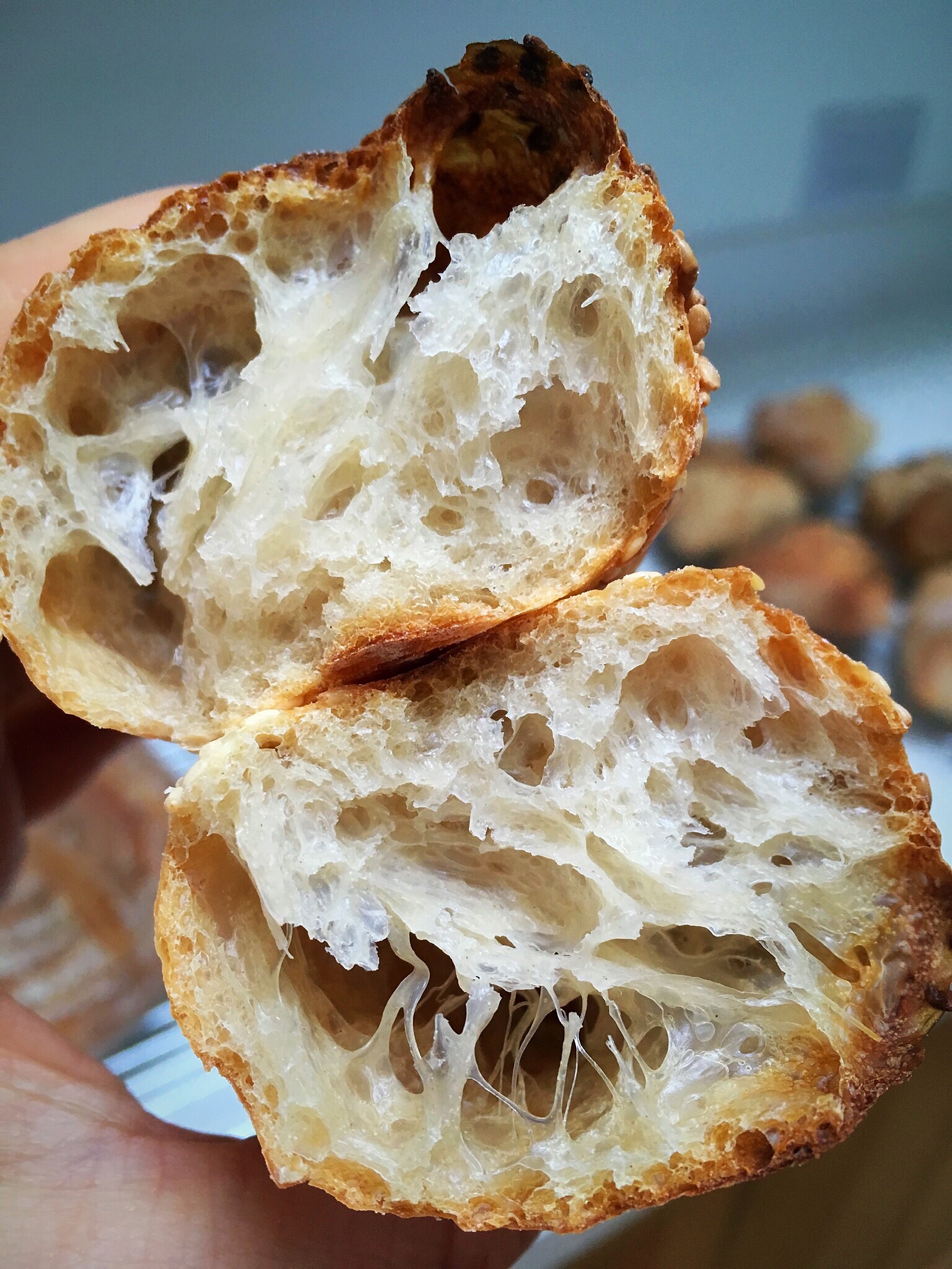
The rolls are made using my master recipe dough again, but this time direct from the banneton, maybe my simplest method for making rolls yet!
Following the overnight prove, bring the dough gently together and place it into a well rice floured banneton, cover, and place it in the fridge as per the recipe process.
You can then use this whenever you are ready to make the rolls; I have used dough that’s been in the fridge for 3 hours and up to 31 hours and everything in between to make these rolls. The point being that you can have the dough ready to use whenever you need it.
It gives you full control over the timing – you don’t need to held hostage by the dough!
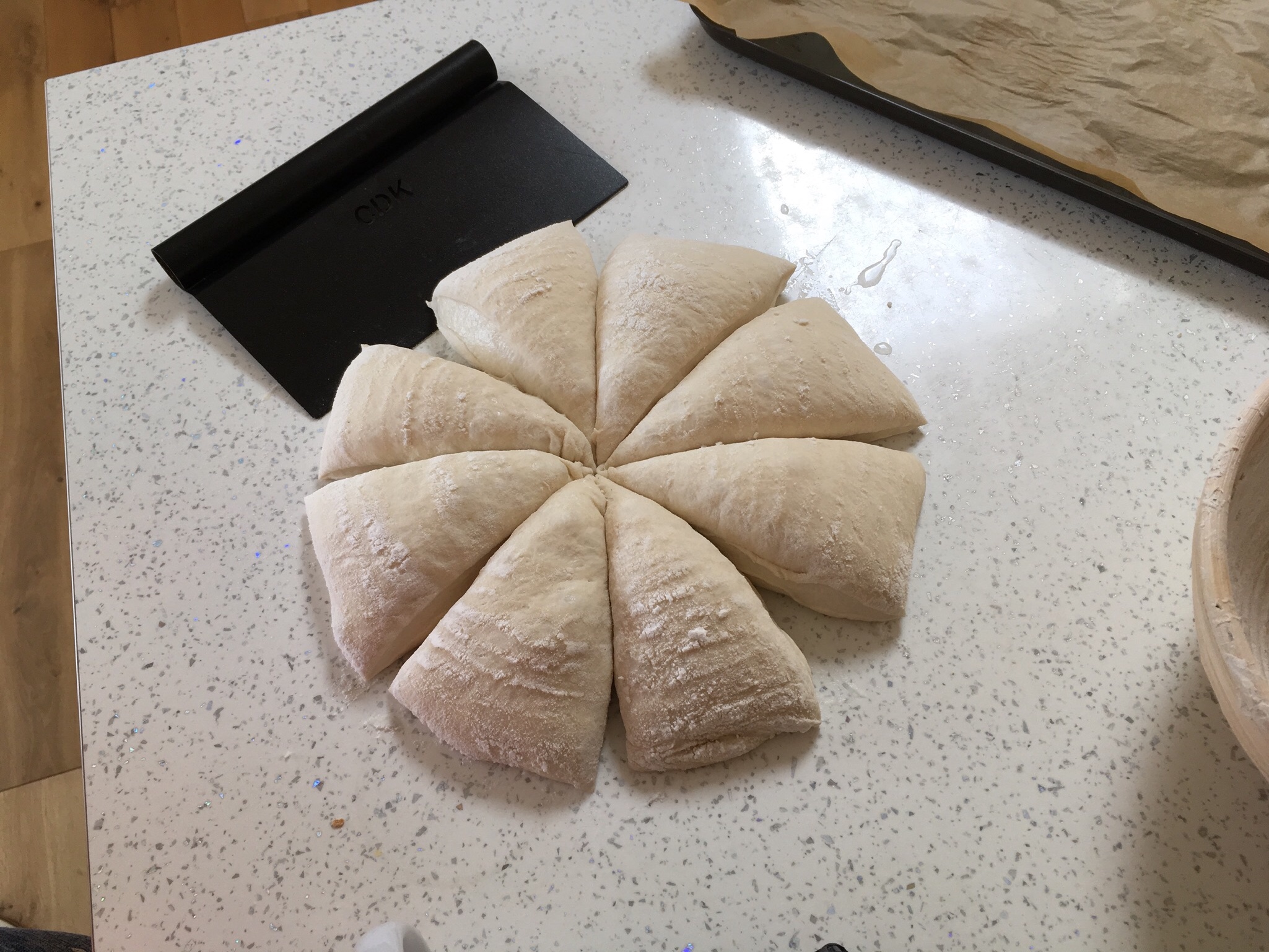
When you’re ready, sprinkle some water onto your counter surface.
Turn the dome of dough gently out onto the counter.
Using a dough cutter, cut into 8 or 12 wedges.

*At this point you can gently place the pieces of dough into chopped nuts, seeds, oats (as baked below), whatever you like. You can try and keep the wedge shape or wind them into other shapes, or just splodge them on the tray (see the photos below of a chopped pecan studded roll made by placing the cut wedge into the chopped nuts then wound into a swirl).


Place the wedges onto a prepared tray.
You can now bake these from cold start, or in a preheated oven.
They don’t need to be covered and no steam is required.
Cold start: Place the tray into the cold oven, turn it up to 220C fan, 240 non fan, 450F, and bake for 20-25 mins until browned and risen
Hot start: Preheat the oven to 220C fan, 240 non fan, 450F, and bake for 20-22 mins until browned and risen


To see this in action, check out the video on my YouTube channel showing exactly how I make them: https://youtu.be/YCVqTOJwzSY


Happy Baking!
My master recipe sourdough pizza…

UPDATE: this was the first ever time I had made pizza with my master recipe. I have since made many more sourdough pizzas and have tested and perfected my process and have these recipes fully written up and detailed in my books, The Sourdough Whisperer and Easy Everyday Sourdough Bread Baking.
The Sourdough Whisperer: https://foodbodsourdough.com/my-new-book/
Easy Everyday Sourdough Bread Baking: https://foodbodsourdough.com/my-new-book-for-2023/
You can now also find a new and updated version of my pizza making here: https://foodbodsourdough.com/pizza-dough/
ORIGINAL POST: This recipe uses the dough created using my master recipe process and then using it to create the pizza of your choice; the dough can be made up of the flour/s of your choice to create different flavours & textures…
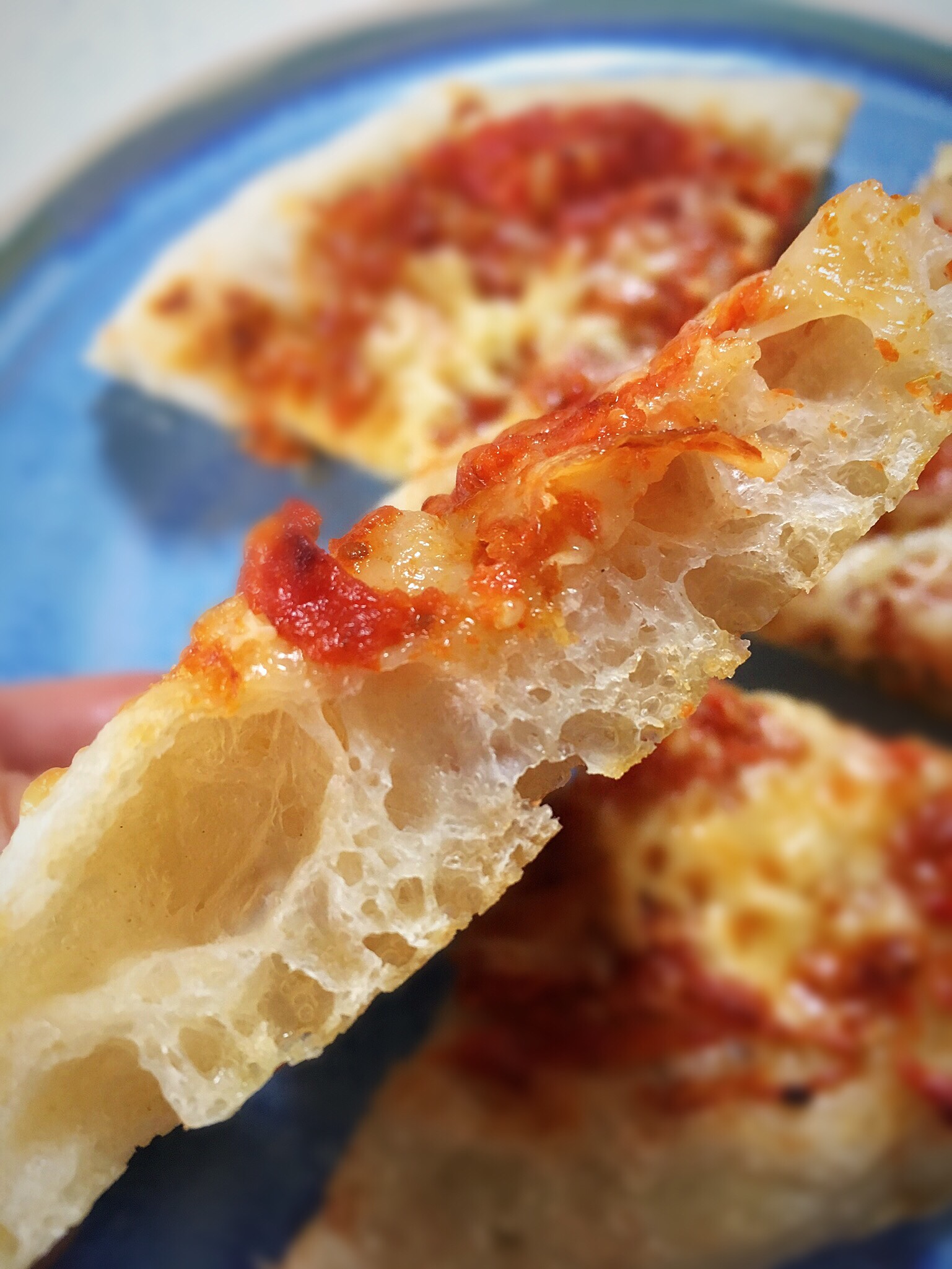
The outcome being a lovely textured, holey, tasty pizza base!
The key is how to manage and store the overnight dough ready for when you want your pizzas. I have got 2 methods below, each designed to make it simple to fit the dough in with your timings, and not the other way round!
Method 1.
The morning after the overnight prove, you will hopefully have a lovely big bowl of well proved dough, place the covered bowl in the fridge. If the dough hasn’t reached the top of the bowl already, just place it in the fridge to bring the activity to a halt until you want to use it.
When you know when you want your pizzas to be ready for, remove the dough from the fridge an hour or so beforehand and let it warm up a bit.
Cover your work surface with water, flour or olive oil.
Turn the dough out from the bowl onto your surface and cut into portions, 2, 4 or 6, depending how big you would like your pizzas to be.
Let it sit for 10 minutes.
**I use a foil lined baking tray to cook my pizzas, liberally drizzled with olive oil (I like the crust it generates when baked). However, you may prefer using semolina, polenta/corn meal, flour, whatever your choice under the dough, directly onto your baking tray or baking implement of your choice. If you’re using a pizza stone, prepare the dough on a board or tray ready to be able to move it across to your stone as you usually do.
After 10 minutes place the dough on your chosen bakeware, and start to gently use your finger tips to push the dough out into a thinner rounder shape, or shape of your choice. You will need to let it sit for a few minutes and then do it again as the dough will bounce back.
Preheat the oven to 220C fan/240 non fan/460F.
Give your dough one final push out, spread with sauce of your choice and toppings of your choice, and bake for 12-15 minutes until the base is cooked and the cheese is bubbling.
Enjoy!
Method 2.
In the morning you will hopefully have a lovely big bowl of perfectly proved dough. Cover your work surface in flour, water or oil, and turn the dough out onto the surface.
Prepare your baking tray, I drizzle olive oil over my foil lined tray as stated above.
Portion the dough into 2, 4 or 6 pieces.
Let it sit for 10 minutes.
Place the pieces onto your prepared baking tray and use your fingers tips to push it gently out into a round; it will want to bounce back so let it set for a while and do it again.
Once you’ve got it pushed out to the thinness and size that you want, cover the whole tray with a large plastic bag, or place cling film over the dough, and put the whole tray in the fridge.
It can now sit in there until you want to use it, I’ve let mine sit in the fridge all day in the past.
You can now use this dough directly from the fridge, you don’t need to let it warm up or come to room temperature, you can just add your toppings and bake.
If you’re more comfortable letting it come to room temperature before baking you can do that too.
Preheat the oven to 220C fan/240 non fan/460F, and bake for 12-15 minutes until the base is cooked and the cheese is bubbling.
Enjoy!

Beautiful blistered base, and it tastes SOOOO good!

My sourdough pitta breads…

Pita or pitta, which ever spelling you use, here’s my sourdough version…
🌟🌟🌟 You can now find a same day sourdough pita recipe in my new book 🌟🌟🌟
As I have with other recipes, I’ve used my master recipe and process to make these. I’ve used 100% strong white bread flour in the dough, and on other occasions I’ve used a mix of strong white bread flour and spelt, and a version with kamut flour; basically, whatever dough you choose to put together (there’s more suggestions in this recipe collection), you can convert it to making rolls, focaccia, pizza dough, or now these pittas.

Follow my master recipe process up to and including the overnight prove, and then use that dough to create these bread pockets.
NOTE: if your dough has proved overnight and is reaching the top of the bowl or hitting the shower cap by the early morning but you’re not ready to use it yet, gently do one round of pulls and folds to calm it down a bit, then cover it again to allow it to grow and fill the bowl again over the next 2-3 hours for when you want to use it.
When you’re ready to use for the dough for your pittas…
Method
Preheat your oven to 250C and place a tray in the oven to heat up.
Take your overnight proved dough, gently pull it into a loose ball to enable you to turn it out onto a floured surface.
Using a dough knife, cut the dough into 8 pieces, as equal as you can by eye.

Very gently shape each piece into a ball.

Using a rolling pin, roll each ball into a larger flat circle or an oval 2-3mm thick.

When the oven is ready, quickly remove the tray from the oven (to maintain the heat in the oven as much as possible), quickly place (or throw!) the rolled pieces of dough onto the tray, place it back into the oven and bake for 5-6 mins maximum.
**Depending on how many you are baking and how big your tray is, you may need to bake these in a couple of batches. If that is the case, roll one set, bake them, then roll the next set and bake them, rather than rolling them all at once and have some of them sitting on the counter for too long.
You should see them puff up during the bake.
Remove from the tray from the oven and place the breads onto a rack to cool slightly before eating, or save for later.


Beware: they will be very hot.

Enjoy!
